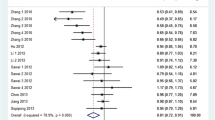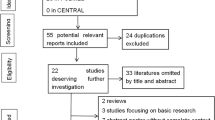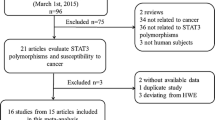Abstract
The present study was undertaken to quantitatively evaluate the association between rs3746444 polymorphism and HCC risk. In this analysis with 667 cancer cases and 1,006 control subjects, we summarized 4 eligible case–control studies by searching databases of PubMed, EMBASE, and CNKI. The strength of the association was assessed by calculating odds ratios (ORs) with 95 % confidence intervals (CIs) with the fixed-effects model. We found that neither the allele frequency nor genotype distribution of this polymorphism was associated with risk of HCC in any genetic model. Similarly, no associations were suggested either in subgroup analyses by ethnicity or by source of control. Our research suggested that rs3746444 polymorphism may not be a risk factor for HCC. However, well-designed studies with a larger sample size are needed to confirm these findings.


Similar content being viewed by others
References
Forner, A., Llovet, J. M., & Bruix, J. (2012). Hepatocellular carcinoma. Lancet, 379(9822), 1245–1255.
Maluccio, M., & Covey, A. (2012). Recent progress in understanding, diagnosing, and treating hepatocellular carcinoma. CA: A Cancer Journal for Clinicians, 62(6), 394–399.
Montesano, R., Hainaut, P., & Wild, C. P. (1997). Hepatocellular carcinoma: from gene to public health. c, 89(24), 1844–1851.
Bruix, J., et al. (1989). Prevalence of antibodies to hepatitis C virus in Spanish patients with hepatocellular carcinoma and hepatic cirrhosis. Lancet, 2(8670), 1004–1006.
Ross, R. K., et al. (1992). Urinary aflatoxin biomarkers and risk of hepatocellular carcinoma. Lancet, 339(8799), 943–946.
Marrero, J. A., et al. (2005). Alcohol, tobacco and obesity are synergistic risk factors for hepatocellular carcinoma. Journal of Hepatology, 42(2), 218–224.
Thorgeirsson, S. S., & Grisham, J. W. (2002). Molecular pathogenesis of human hepatocellular carcinoma. Nature Genetics, 31(4), 339–346.
Hagymasi, K., & Tulassay, Z. (2008). Epidemiology, risk factors and molecular pathogenesis of primary liver cancer. Orvosi Hetilap, 149(12), 541–548.
Bartel, D. P. (2004). MicroRNAs: Genomics, biogenesis, mechanism, and function. Cell, 116(2), 281–297.
Esquela-Kerscher, A., & Slack, F. J. (2006). Oncomirs—microRNAs with a role in cancer. Nature Reviews Cancer, 6(4), 259–269.
Wienholds, E., & Plasterk, R. H. (2005). MicroRNA function in animal development. FEBS Letters, 579(26), 5911–5922.
Chen, J. F., et al. (2006). The role of microRNA-1 and microRNA-133 in skeletal muscle proliferation and differentiation. Nature Genetics, 38(2), 228–233.
Brennecke, J., et al. (2003). Bantam encodes a developmentally regulated microRNA that controls cell proliferation and regulates the proapoptotic gene hid in Drosophila. Cell, 113(1), 25–36.
Cimmino, A., et al. (2005). MiR-15 and miR-16 induce apoptosis by targeting BCL2. Proceedings of the National Academy of Sciences, 102(39), 13944–13949.
Skalsky, R. L., & Cullen, B. R. (2011). Reduced expression of brain-enriched microRNAs in glioblastomas permits targeted regulation of a cell death gene. PLoS ONE, 6(9), e24248.
Hatfield, S. D., et al. (2005). Stem cell division is regulated by the microRNA pathway. Nature, 435(7044), 974–978.
Calin, G. A., et al. (2008). MiR-15a and miR-16-1 cluster functions in human leukemia. Proceedings of the National Academy of Sciences, 105(13), 5166–5171.
Iorio, M. V., et al. (2005). MicroRNA gene expression deregulation in human breast cancer. Cancer Research, 65(16), 7065–7070.
Chan, J. A., Krichevsky, A. M., & Kosik, K. S. (2005). MicroRNA-21 is an antiapoptotic factor in human glioblastoma cells. Cancer Research, 65(14), 6029–6033.
Zeng, Y., et al. (2010). Correlation between pre-miR-146a C/G polymorphism and gastric cancer risk in Chinese population. World Journal of Gastroenterology, 16(28), 3578–3583.
Akkiz, H., et al. (2011). Genetic variation in the microRNA-499 gene and hepatocellular carcinoma risk in a Turkish population: lack of any association in a case-control study. Asian Pacific Journal of Cancer Prevention, 12(11), 3107–3112.
Zhou, J., et al. (2012). Association between two genetic variants in miRNA and primary liver cancer risk in the Chinese population. DNA and Cell Biology, 31(4), 524–530.
Xiang, Y., et al. (2012). Association of the microRNA-499 variants with susceptibility to hepatocellular carcinoma in a Chinese population. Molecular Biology Reports, 39(6), 7019–7023.
Kim, W. H., et al. (2012). Association study of microRNA polymorphisms with hepatocellular carcinoma in Korean population. Gene, 504(1), 92–97.
Hu, M., et al. (2013). The association between two common polymorphisms in MicroRNAs and hepatocellular carcinoma risk in Asian population. PLoS ONE, 8(2), e57012.
Yin, Z., et al. (2013). Effects of common polymorphisms rs2910164 in miR-146a and rs3746444 in miR-499 on cancer susceptibility: a meta-analysis. Molecular Biology Reports, 40(4), 3003–3013.
Lau, J., Ioannidis, J. P., & Schmid, C. H. (1997). Quantitative synthesis in systematic reviews. Annals of Internal Medicine, 127(9), 820–826.
MANTEL, N., & HAENSZEL, W. (1959). Statistical aspects of the analysis of data from retrospective studies of disease. Journal of the National Cancer Institute, 22(4), 719–748.
DerSimonian, R., & Laird, N. (1986). Meta-analysis in clinical trials. Controlled Clinical Trials, 7(3), 177–188.
Egger, M., et al. (1997). Bias in meta-analysis detected by a simple, graphical test. BMJ, 315(7109), 629–634.
Chen, L. T., et al. (2012). MicroRNA-378 is associated with non-small cell lung cancer brain metastasis by promoting cell migration, invasion and tumor angiogenesis. Medical Oncology, 29(3), 1673–1680.
Lu, Y., et al. (2007). Transgenic over-expression of the microRNA miR-17-92 cluster promotes proliferation and inhibits differentiation of lung epithelial progenitor cells. Development Biology, 310(2), 442–453.
Yang, W., et al. (2006). Modulation of microRNA processing and expression through RNA editing by ADAR deaminases. Nature Structural and Molecular Biology, 13(1), 13–21.
Author information
Authors and Affiliations
Corresponding author
Additional information
Fangfeng Liu and Hongfeng Lin are Co-first authors.
Rights and permissions
About this article
Cite this article
Liu, F., Lin, H., Cheng, Y. et al. rs3746444 Polymorphism and Susceptibility to Hepatocellular Carcinoma: Evidence from Published Studies. Cell Biochem Biophys 70, 1957–1961 (2014). https://doi.org/10.1007/s12013-014-0156-5
Published:
Issue Date:
DOI: https://doi.org/10.1007/s12013-014-0156-5




